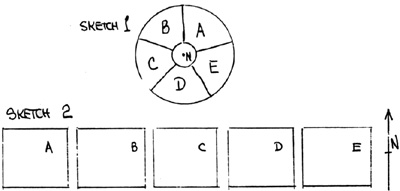 Seeking something to salvage from the ACW scenario that fell
flat (or did it fall "flatly"?) as described in the January
REVIEW, the following method of generating an encounter between
two forces was implemented.
Seeking something to salvage from the ACW scenario that fell
flat (or did it fall "flatly"?) as described in the January
REVIEW, the following method of generating an encounter between
two forces was implemented.
First, the map ... as shown in Sketch 1, it consists of five potential battlefields, A, B, C, D, and E, in a ring-like formation around the "north pole". The north pole is put there solely to give us a reference direction. When the five fields are placed in line, Sketch 2, we merely get a strip of five adjacent table tops, with the proviso that one must remember that the right (east) end of Table E is joined to the left (west) end of Table A.
Second, we have Commander Alpha, who is given the task of defending the northern baselines of A, B, C, D, and E. He must, therefore, spread his forces out along the five tables.
Third, Commander Beta. His task is to defend the southern baselines, and so he, too, is strung out across five tables.
Fourth, the dice throw. This will decide whose force has just been given orders to change from the defense to the attack. He decides on a single one of the five battlefields on which he will mount his attack, and the battle will be fought on this table.
And fifth, the battle itself. Here, the chosen table top - either A, B, C, D, or E - is set up the troops that both Alpha and Beta had initially assigned to that particular table are placed thereon, and the game begins. During the battle, off-board movement takes place each turn as the troops that Alpha and Beta had assigned to other tables slowly move toward the battlefield.
 For purposes of off-table movement, A, B, C, D, and E are each
divided in half as shown in Sketch 3. During the initial
placement of troops on the five tables, they are designated as
being in either the western (Sector 1) or eastern (Sector 2) half
of their assigned table. Each game turn, the off-table forces can
move one sector.
For purposes of off-table movement, A, B, C, D, and E are each
divided in half as shown in Sketch 3. During the initial
placement of troops on the five tables, they are designated as
being in either the western (Sector 1) or eastern (Sector 2) half
of their assigned table. Each game turn, the off-table forces can
move one sector.
Thus if Table A is selected for the battle, then the troops farthest removed from A would be those placed on Table C. These would require the following number of game turns to arrive on their side's baseline:
| If the force started in Sector C1 and marched west, it reaches: | Turn Number | If the force
started in Sector C2 and marched east, it reaches: |
|---|---|---|
| Sector B2 | 1 | Sector D1 |
| Sector B1 | 2 | Sector D2 |
| Sector A2* | 3 | Sector E1 |
| - | 4 | Sector E2 |
| - | 5 | Sector A1** |
*Force arrives on eastern edge of baseline.
**Force arrives on western edge of baseline.
There are no off-table encounters ... not unless you are gifted with an umpire who delights in resolving such situations. By eliminating the off-table battles, the tactical flanking force movement can be accomplished solely by the two players, with no need for an umpire.
Each of the tables can be pre-mapped and assigned terrain items. In such case, Alpha may see, for example, that Table B gives him a good defensive position, in which case Beta, most probably, wouldn't choose B on which to attack. Alpha, therefore, may assign less of his troops to Table B, and instead, mass them on a table better structured for his own attack. This, of course, may cause him to get caught short if Beta wins the dice toss, becomes the attacker and goes on the offensive on a table far removed from the one on which Alpha gathered his troops.
Back to PW Review March 1988 Table of Contents
Back to PW Review List of Issues
Back to MagWeb Master Magazine List
© Copyright 1988 Wally Simon
This article appears in MagWeb (Magazine Web) on the Internet World Wide Web.
Other articles from military history and related magazines are available at http://www.magweb.com